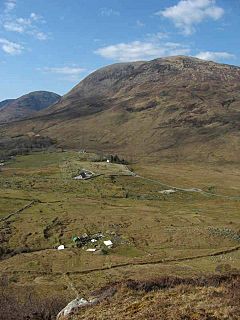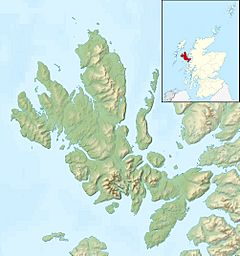High Pasture Cave facts for kids
|
Uamh An Ard-Achaidh
|
|

High Pasture Cave
|
|
| Location | Kilbride, island of Skye |
|---|---|
| Region | Scotland |
| Coordinates | 57°12′50″N 6°0′40″W / 57.21389°N 6.01111°W |
| Type | limestone |
| Part of | Red Cuillin |
| Length | 320 m (1,050 ft) |
| History | |
| Periods | Mesolithic, Iron Age |
| Associated with | Paleo Humans |
| Site notes | |
| Excavation dates | 1972, 2003 |
| Archaeologists | Steven Birch |
High Pasture Cave (called Uamh An Ard-Achaidh in Gaelic) is an amazing archaeological site on the Isle of Skye in Scotland. People have lived or visited here since the Mesolithic period, which was thousands of years ago. Inside the cave, archaeologists have found structures from the Iron Age. These finds suggest that the cave was a special place. People might have used it for important ceremonies or to honor the land and its ancient spirits. The cave system has about 320 meters (1,050 feet) of passages that people can explore.
Contents
Exploring High Pasture Cave
This ancient cave is located about 1 kilometer (0.6 miles) southeast of the village of Torrin. It's also close to Kilbride. The cave entrance is found in a narrow valley. This valley is on the northern slopes of Beinn Dùbhaich mountain. It's also east of the Red Cuillin hills. The cave itself was formed by water slowly wearing away a type of rock called Durness limestone.
To get inside, you go down a natural shaft. This shaft is about 6 meters (20 feet) deep. It leads into the main part of the cave. People seem to have used this main cave between 1,200 BC and 200 BC. This time period covers the mid-Bronze Age up to the late Iron Age. After about 80 meters (260 feet) inside, the cave splits. One path is a rocky, dry passage. In 2002, a cave explorer named Steven Birch made an important discovery here. He found broken pottery and bones. Other visitors had thrown these items aside while looking for new paths. Birch realized how valuable these finds were. He understood the cave's great historical importance.
Discovering the Past: Excavations
The High Pasture Cave system was first explored by archaeologists in 1972. These early excavations were done by students from the University of London Speleological Society. A much bigger excavation project started in 2003. This work lasted a full year. It was mainly supported by Historic Scotland. Steven Birch and Martin Wildgoose led the ongoing research at the site.
Amazing Finds from the Cave
Archaeologists have found many different items in and around the cave. These include tools made of stone, bone, and antler. They also found traces of metalworking. Well-preserved animal bones were also discovered.
Life in the Mesolithic Period
Tiny arrowheads found in the cave show that nomadic hunters used the area. These hunters lived here during the Mesolithic period. This was about 6,000 to 7,000 years ago. The cave was only visited sometimes during the Neolithic and Bronze Age. But around 800 BC, people started coming to the site more often. A large fireplace was built right in front of the cave entrance. This entrance area might have been used for ceremonies. It could also have been a place to store personal belongings.
Changes Over Time
Over the next 1,000 years, the entrance to the cave started to get blocked. This was due to all the activities and ash from the fire pit. To keep the cave open, people built a staircase. This staircase was about 4 meters (13 feet) long. Hundreds of items were found around the fire pit and on the cave floor. These included bronze, bone, and antler needles. Glass and ivory beads were also discovered. All these finds show that the cave was a very busy place. This intense activity continued until about 40 BC. At that time, the stairs were completely filled with large rocks and earth. Human remains were carefully placed on top of this filling.
A Musical Discovery
In 2012, a special piece of carved wood was found. Experts believe it is the bridge from a lyre. A lyre is an ancient stringed musical instrument. This small, burnt, and broken piece of wood is very old. It has been dated to around 300 BC. This makes it the earliest discovery of a stringed instrument in Western Europe! You can still clearly see the small notches where the strings would have been placed. According to Graeme Lawson, a music archaeologist, this find is very important. It "pushes the history of complex music [in Britain] back more than a thousand years." If this dating is correct, it suggests that local Celtic people might have had contact with cultures from the Mediterranean region.



